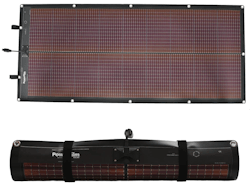Customizing Flexible Power Solutions for IoT Applications
Check out our Sensors Converge 2023 coverage.
What you'll learn:
- What types of solar panels are available off the shelf?
- Considerations for designing in solar-power solutions.
- Why there are different solar-power solutions.
Solar panels have been around a long time, many of which are built from solid materials. A more flexible solution can be useful especially for mobile applications—an arena that PowerFilm Solar knows well.
Seth Hansen, PowerFilm Solar’s Marketing and Communication Manager, provides a good overview of some of the company's more flexible energy-harvesting solutions (see the video above). PowerFilm sells different versions of its technology like the Rollable Solar Panel (Fig. 1), which comes in many sizes and energy-harvesting power levels starting at 7 W to over 60 W.
Flexible power solutions come in many different packages, such as the Foldable Solar Panel (Fig. 2). Versions are available that can supply up to 100 W of power from a 4.6-lb. solution that unfolds to a 14- × 13.5-in. rectangle.
Some of the systems come with a built-in battery while others provide power using standard connectors. These can be used to charge batteries or power devices directly. Many of the consumer-oriented products are utilized by campers, ham radio operators, and others that need electronic or electrical devices in the field. Systems are designed to meet rugged requirements using marine-grade connectors and weather-resistant fabric.
Furthermore, embedded developers can work with PowerFilm to develop customized solutions. They have a number of development kits available (Fig. 3). There's even a Bluetooth Low Energy (BLE) reference design built around a Nordic Semiconductor nRF52832 SoC.
Both the website and the video point out the differences between solar panels designed for indoor and outdoor use. Designers should be aware of the differences in longevity, suitability for difference wavelengths of light, etc. Thus, it's not just a matter of choosing a size and power output when specifying needed parts.
Check out more of our Sensors Converge 2023 coverage.
Links
About the Author
William G. Wong
Senior Content Director - Electronic Design and Microwaves & RF
I am Editor of Electronic Design focusing on embedded, software, and systems. As Senior Content Director, I also manage Microwaves & RF and I work with a great team of editors to provide engineers, programmers, developers and technical managers with interesting and useful articles and videos on a regular basis. Check out our free newsletters to see the latest content.
You can send press releases for new products for possible coverage on the website. I am also interested in receiving contributed articles for publishing on our website. Use our template and send to me along with a signed release form.
Check out my blog, AltEmbedded on Electronic Design, as well as his latest articles on this site that are listed below.
You can visit my social media via these links:
- AltEmbedded on Electronic Design
- Bill Wong on Facebook
- @AltEmbedded on Twitter
- Bill Wong on LinkedIn
I earned a Bachelor of Electrical Engineering at the Georgia Institute of Technology and a Masters in Computer Science from Rutgers University. I still do a bit of programming using everything from C and C++ to Rust and Ada/SPARK. I do a bit of PHP programming for Drupal websites. I have posted a few Drupal modules.
I still get a hand on software and electronic hardware. Some of this can be found on our Kit Close-Up video series. You can also see me on many of our TechXchange Talk videos. I am interested in a range of projects from robotics to artificial intelligence.



